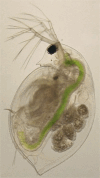Maternal effects in the model system Daphnia: the ecological past meets the epigenetic future
- PMID: 39779907
- PMCID: PMC11799227
- DOI: 10.1038/s41437-024-00742-w
Maternal effects in the model system Daphnia: the ecological past meets the epigenetic future
Erratum in
-
Correction: Maternal effects in the model system Daphnia: the ecological past meets the epigenetic future.Heredity (Edinb). 2025 Jul;134(7):450. doi: 10.1038/s41437-025-00771-z. Heredity (Edinb). 2025. PMID: 40410367 Free PMC article. No abstract available.
Abstract
Maternal effects have been shown to play influential roles in many evolutionary and ecological processes. However, understanding how environmental stimuli induce within-generation responses that transverse across generations remains elusive, particularly when attempting to segregate confounding effects from offspring genotypes. This review synthesizes literature regarding resource- and predation-driven maternal effects in the model system Daphnia, detailing how the maternal generation responds to the environmental stimuli and the maternal effects seen in the offspring generation(s). Our goal is to demonstrate the value of Daphnia as a model system by showing how general principles of maternal effects emerge from studies on this system. By integrating the results across different types of biotic drivers of maternal effects, we identified broadly applicable shared characteristics: 1. Many, but not all, maternal effects involve offspring size, influencing resistance to starvation, infection, predation, and toxins. 2. Maternal effects manifest more strongly when the offspring's environment is poor. 3. Strong within-generation responses are typically associated with strong across-generation responses. 4. The timing of the maternal stress matters and can raise or lower the magnitude of the effect on the offspring's phenotype. 5. Embryonic exposure effects could be mistaken for maternal effects. We outline questions to prioritize for future research and discuss the possibilities for integration of ecologically relevant studies of maternal effects in natural populations with the molecular mechanisms that make them possible, specifically by addressing genetic variation and incorporating information on epigenetics. These small crustaceans can unravel how and why non-genetic information gets passed to future generations.
© 2025. The Author(s).
Conflict of interest statement
Competing interests: The authors declare no competing interests. Research ethics: Not needed.
Figures




Similar articles
-
The maternal effects of dietary restriction on Dnmt expression and reproduction in two clones of Daphnia pulex.Heredity (Edinb). 2023 Feb;130(2):73-81. doi: 10.1038/s41437-022-00581-7. Epub 2022 Dec 7. Heredity (Edinb). 2023. PMID: 36477021 Free PMC article.
-
Transgenerational epigenetic inheritance increases trait variation but is not adaptive.Evolution. 2025 Jun 14;79(6):1033-1043. doi: 10.1093/evolut/qpaf050. Evolution. 2025. PMID: 40065197 Free PMC article.
-
Transgenerational effects of poor elemental food quality on Daphnia magna.Oecologia. 2010 Apr;162(4):865-72. doi: 10.1007/s00442-009-1517-4. Epub 2009 Dec 2. Oecologia. 2010. PMID: 19957090
-
Parental genetic effects on the offspring's phenotype without transmission of the gene itself-pathophysiology and clinical evidence.Am J Physiol Cell Physiol. 2024 Sep 1;327(3):C750-C777. doi: 10.1152/ajpcell.00359.2024. Epub 2024 Jul 16. Am J Physiol Cell Physiol. 2024. PMID: 39010843 Review.
-
Epigenetics in comparative biology: why we should pay attention.Integr Comp Biol. 2014 Jul;54(1):7-20. doi: 10.1093/icb/icu013. Epub 2014 Apr 9. Integr Comp Biol. 2014. PMID: 24722321 Free PMC article. Review.
Cited by
-
FAIRification of the DMRichR pipeline: advancing epigenetic research on environmental and evolutionary model organisms.Bioinform Adv. 2025 Feb 6;5(1):vbaf024. doi: 10.1093/bioadv/vbaf024. eCollection 2025. Bioinform Adv. 2025. PMID: 40041115 Free PMC article.
References
-
- Agrawal AA, Laforsch C, Tollrian R (1999) Transgenerational induction of defenses in animals and plants. Nature 401:60–63
-
- Alstad NW, Skardal L, Hessen DO (1999) The effect of calcium concentration on the calcification of Daphnia magna. Limnol Oceanogr 44:2011–2017
-
- Anastasiadi D, Venney CJ, Bernatchez L, Wellenreuther M (2021) Epigenetic inheritance and reproductive mode in plants and animals. Trends Ecol Evol 36(12):1124–1140 - PubMed
-
- Arnold DE (1971) Ingestion, assimilation, survival, and reproduction by Daphnia pulex fed seven species of blue-green algae. Limnol Oceanogr 16(6):906–920
Publication types
MeSH terms
Grants and funding
LinkOut - more resources
Full Text Sources
Miscellaneous

